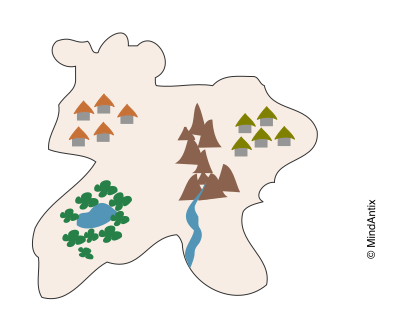What do Emily Bronte, Friedrich Neitzsche and Wolfgang Amadeus Mozart have in common apart from the fact that they were all highly distinguished in their chosen fields? One thing that ties them together is that they all engaged in building complex imaginary worlds, or paracosms, when they were children.
Emily Bronte along with her siblings created “Glass Town” situated somewhere in Africa. Neitzsche and his sister created an imaginary world with a squirrel as the King, and Mozart created the Kingdom of Back with his sister. All of these worlds were highly complex and their creators spent many months defining and elaborating various aspects of their world.
This kind of childhood play is significantly different from other kinds of imaginary play children typically play in. This kind of make believe play doesn’t end at bedtime but persists for much longer often stretching into months or even years. The imaginary world keeps growing organically and accumulates stories, culture, politics and even distinct languages.
What Is Worldplay?
Michelle Root-Bernstein, a creativity scholar, who studies imaginary worlds in children believes that worldplay has ties to creativity and giftedness. In a research study she found that the prevalence of worldplay was significantly higher among recipients of MacArthur genius awards compared to a group of undergraduate students. The MacArthur Fellows came from different disciplines in sciences and humanities, and the undergraduate group was selected to match their profile.
Creating paracosms may seem like a frivolous activity but it builds skills that are essential for success. As Root-Bernstein explains, “childhood worldplay does appear to provide an early apprenticeship in absorption and persistence, discovery, synthesis, and modeling.”
As children start elaborating their worlds, they not only build their imaginative skills but many others like empathy (understanding different characters’ problems), logical thinking (building rules and societal structures) or problem solving (resolving conflicts between groups). But most importantly, children also begin to realize that society and its rules were created by other people like them and are just as malleable as the rules in their imaginary worlds, giving them the confidence to imagine new solutions to human challenges.
Despite the benefits of worldplay, it is much less prevalent now than a generation ago. With the proliferation of technology, children spend their free time exploring readily available commercial worlds in games, instead of using their imagination to invent their own. This, unfortunately, deprives them of an opportunity to develop lifelong creativity skills.
Worldplay As A Pedagogical Tool
Inspired by the benefits of worldplay, we created a project-based learning (PBL) program for younger students to design their own fantasy worlds. We realized that the project was a fertile playground to teach different concepts and subject areas while keeping students engaged. Some of the topics we covered were myths, ecosystems and numbering systems, and in each area students had to create their own versions. Below are some examples:
- Myths: In one session we learned that all cultures have traditional stories or myths that explain the history or some other natural phenomena. Myths arose because people didn’t have the scientific knowledge to understand the world around them. These stories became a way to make sense of the world around them and could often be a vehicle for other moral lessons. After we discussed different kinds of myths, students created myths to explain some aspect of their own world.
- Numbering Systems: We explored how different numbering systems evolved in human history to keep up with our growing needs. The earliest forms of counting was through tally marks which became impractical when large numbers were involved. The next “invention” was to assign symbols for larger numbers (like ‘C’ denotes 100 in Roman numerals). Similarly, place-value was another improvement that made it easier to do arithmetic operations. After students see how the decimal system we use now is the product of multiple iterations over hundreds of years, they take on the task to design their own numbering system with their own symbols (which often include emojis) and choice of base.
- Ecosystems: We studied different kinds of interdependent relations and how these mutually beneficial relationships help the ecosystem survive. For example, crocodiles allow birds to pick food that’s stuck to their teeth – this helps the crocodiles keep their teeth clean and the birds get easy access to food. Similarly, bees get food from flowering plants and in return help in pollination. Students then explore how different inhabitants in their world could potentially co-exist in beneficial ways.
While much shorter than typical worldplay, we felt that the project gave students an opportunity to build a deeper understanding of academic concepts by exploring their own imaginary worlds. It’s easy to include topics from different disciplines in sciences and humanities, making this a useful pedagogical tool for educators to use in their classrooms.
Key Takeaways
When most people talk about play for kids, they usually think of play that lasts for a few hours. But just as important is a deeper kind of play – one that engages children over many months as they create and develop their own imaginary worlds.
- Building 21st Century Skills: Creating imaginary worlds gives a playground for children to learn empathy, problem solving and creativity – skills that lead to higher accomplishments in adulthood. Worldplay gives children a sense of agency in their imaginary worlds, which they are more likely to bring into the real world as they pursue their creative endeavors.
- Worldplay at Home: As a parent you can encourage your child to play more imaginative games in their free time. When they share an imaginative creation, join in their pretend play and find ways for them to elaborate their ideas even more. While not all children may be drawn to extended worldplay, engaging in shorter stretches can still build crucial empathy and problem solving skills.
- Worldplay in Schools: Worldplays can be an effective vehicle to teach academic content as they are so easily extensible. One way to do this is to create a long-running project in the classroom that students keep adding on to as they learn new concepts. By creating a parallel world and applying the concepts they are learning, students get to see things from a different perspective which leads to deeper learning.
This article first appeared on CreativityAndEducation.


